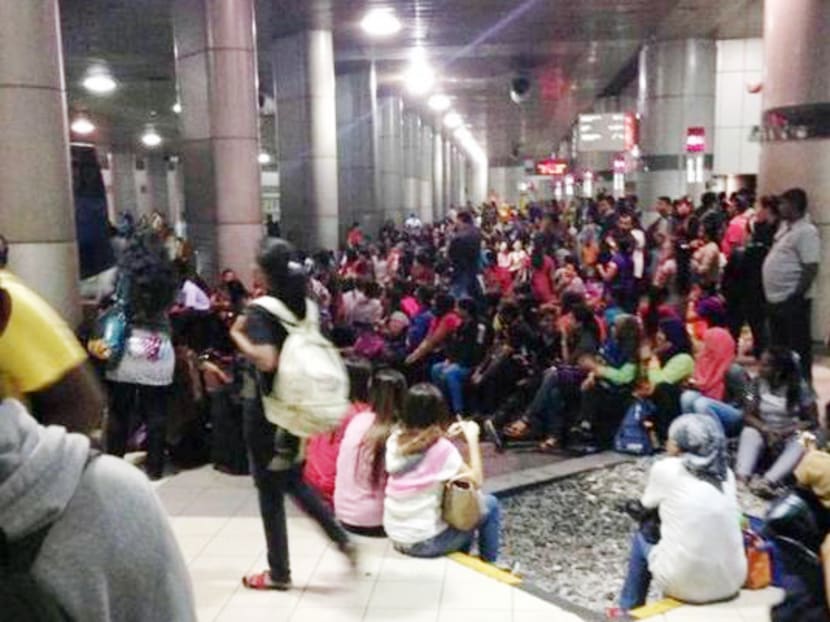Singapore to match Johor’s new Causeway tolls ‘within weeks’

Workers stranded after Malaysian bus drivers staged a strike at the Johor checkpoint. Photo: KS Yong
SINGAPORE — Thousands of tourists, factory workers and schoolchildren had to get off buses and walk across the Causeway early yesterday morning. Many ended up late for work or classes after two bus drivers refused to pay the increased tolls at Malaysian Customs, Immigration and Quarantine Complex (CIQ) and left their vehicles there, blocking traffic for more than three hours.
Yesterday was the first day that the higher tolls — which were increased more than five-fold for all vehicles except motorcycles — imposed by the Malaysian government came into effect. Media reports said the drivers were appeased only after the Malaysian authorities promised a review of the tolls within a week.
In response to media queries, the Land Transport Authority (LTA) reiterated that Singapore will match Malaysia’s new tolls in the next few weeks. The Government had earlier said it would peg its tolls at the Causeway and the Second Link to those set by Malaysia — adhering to a long-standing practice which the Malaysian government is aware of, the LTA spokesman pointed out.
“As details of Malaysia’s toll revisions were not made known to Singapore earlier, the LTA would need some time to operationalise the changes,” he added. “Should Malaysia reduce or do away with the toll charges, Singapore will follow suit.”
On top of the Causeway tolls — which were first mooted in 2011 but were said to be held back in view of Malaysia’s general election last year — the Malaysian government will also be increasing its Vehicle Entry Permit (VEP) fee for all foreign-registered cars entering the country, after a similar move by Singapore.
The LTA spokesman pointed out that Singapore’s VEP and Goods Vehicle Permit (GVP) fees — which were also raised yesterday — are different from Malaysia’s Causeway tolls. “VEP and GVP fees are not intended as revenue generators or to charge vehicles for the usage of the Causeway, Second Link or other roads. Instead, they seek to equalise the cost of owning and using a foreign-registered vehicle in Singapore with that for a Singapore-registered vehicle,” the spokesman said. He added that the need to revise Singapore’s VEP and GVP fees arose from the fact that this cost difference has widened in recent years.
The LTA said that based on data last year, the VEP fee increase will only affect about one in 10 foreign-registered cars. Other foreign-registered cars will not be affected as they enter and stay in Singapore on VEP-free days or during VEP-free hours. Buses, taxis and motorcycles are not affected.
Speaking at a community event, Foreign Affairs and Law Minister K Shanmugam said if the Malaysian authorities are charging motorists for the use of the Causeway, then it is a “totally different matter” from the hikes in the entry fee for foreign-registered cars and goods vehicles implemented by Singapore.
He said: “When we increased the fee, the rationale has to be understood clearly. There’s a certain cost to driving a vehicle in Singapore and in order to be fair to Singaporeans, foreigners should not enjoy an undue advantage. We are talking about congestion in Singapore. It is unfair if our motorists pay a huge amount and foreigners don’t pay anything comparable.”
Mr Shanmugam said he was “not quite sure” if the Malaysian government’s rationale in increasing the Causeway tolls was the same. He noted: “It is affecting the Malaysian workers coming into Singapore.”
On whether the furore would affect ties between the two countries, Mr Shanmugam said he did not think so. He reiterated: “We were very clear as to why we had to increase the VEP, and with the rationale, we are being fair.”
Apart from causing inconvenience to Malaysians making their daily commute to Singapore, the traffic standstill — which started before 5am and lasted till 8am — resulted in some companies here scrambling to arrange for alternative transport to ferry their Malaysian workers to their workplace. The LTA also suspended bus services to Johor at about 8am. before resuming all services more than two hours later.
While initial media reports attributed the jam to a strike by bus drivers, Malaysia’s Ministry Of Works said it was not the case. It added: “What happened was a small commotion caused by the refusal of two bus drivers to pay the toll imposed at the CIQ. The government views this seriously and stern action according to the relevant laws will be taken against the irresponsible bus drivers.”
The ministry said that overall, the toll collection operation has gone smoothly and any operational problems faced have been overcome. It added that Malaysian officials will be deployed at the Causeway to monitor the situation and ensure traffic congestion is reduced.
Malaysian opposition politicians expressed support for the drivers’ action, with Parti Keadilan Rakyat deputy secretary-general Steven Choong posting on Facebook several pictures of him posing with bus drivers at the CIQ while holding a banner denouncing the tolls. Mr Choong said the bus drivers “promised a huge protest a week later” if the decision after the review was “not acceptable”. ADDITIONAL REPORTING BY PAUL LIM






